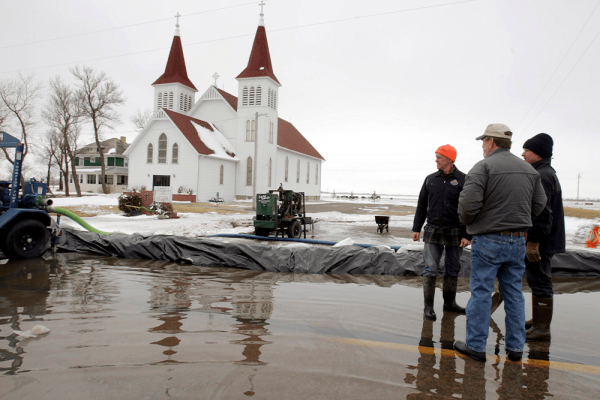In every U.S. congregation, there are likely people experiencing grief, fear, or anger on behalf of creation.
Most Americans now know that the climate is changing; according to recent surveys, a majority now also feel some level of climate-related stress or anxiety. But when terms like “climate grief” and “eco-anxiety” show up in the news, stories often point people toward individual behavior changes or activism, according to a recent study in the journal Environmental Research: Health.
Missing from the conversation is the spiritual dimension of the climate crisis and the role that faith communities can play.
“Grief isn’t just a psychological thing,” said Rev. Chelsea MacMillan, an organizer with the international, multifaith organization GreenFaith. “It brings up big questions about what you believe about life. Why am I here? Why do bad things happen to good people? What do I believe happens when we die?”
These questions, MacMillan told Sojourners, also come up around the climate crisis. But churches, traditionally places where people bear witness to grief, often struggle to respond. “What I've noticed is that actually churches — and other houses of worship, but mostly churches — are stuck around this,” MacMillan said.
Churches march for climate justice, install solar panels, and switch from disposable cups to ceramic mugs. But addressing the spiritual questions behind those actions can be harder.
Climate grief can go unspoken, so it may not seem like an obvious spiritual need. Leaders may also fear poking a wasp's nest and lacking the skills or energy to address deep pain — or the theological and political questions that climate grief may stir. But Dianna VanderDoes, a lay leader at Foothills Unitarian in Fort Collins, Colo., said, “If you're thinking, ‘I don't know if we have the bandwidth to deal with this,’ You are dealing with it. It’s happening already.”
When VanderDoes first brought a climate grief workshop to her congregation, she remembers a palpable relief in the room.
“There was no one that was like, ‘Why are we upset about this?’ Everyone was like, ‘Yes, this is so heavy on my heart. This is so heavy in my mind,’” she said. Each church is different; at Foothills, sharing fear, guilt, and shame made a taboo topic finally speakable. “It was almost a sense of relaxation, like, ‘Ok! We can talk, and we can sing about it, and we can cry.’”
Rev. Cláudio Carvalhaes, who teaches worship and practical theology at Union Theological Seminary in New York, said that collective processing is “one thing that churches can offer as a counterculture.
“When we have a culture that says, ‘You are on your own,’ the church still says, ‘No, we are a collective.’”
MacMillan says processing together is important even for churches already active in creation care or climate justice work.
“When you don’t meet [grief] and work with it and acknowledge it, it can come out sideways,” she said, noting that small quarrels often have deeper pain at their root.
Acknowledging climate grief is particularly important for youth, who may be facing difficult spiritual questions without language or tools, said Rev. Talitha Aho, author of In Deep Waters: Spiritual Care for Young People in a Climate Crisis. She uses the climate emotions scale from environmentalist Isaias Hernandez to help youth name their emotions. Aho said churches can also help parents process their emotions so they can better support their teens.
For churches not sure where to begin, tools are available. The first strategy is to start small. Holding climate grief does not need to begin as a church-wide priority. Leaders can eventually take on broader efforts. But one-on-one and small group conversations can open the door.
Clergy and lay leaders may want to begin processing their own grief before helping others. MacMillan recommends Lament with Earth, a free, online series of liturgical events from The BTS Center. VanderDoes recommends the book Active Hope by Buddhist thinker Joanna Macy and doctor Chris Johnstone.
For facilitators interested in helping their churches process climate grief, theological answers are thankfully not a prerequisite. Holding space is itself a gift — and can be easier than expected.
MacMillan leads a monthly “climate courage group” for leaders in the GreenFaith network. She finds many people simply appreciate opportunities to talk. Her approach is inspired by the meditation practice via negativa and via positiva, as complementary experiences of God. She begins with the via negativa, letting participants name loss with questions like, “What’s breaking your heart?” or “What are you holding?” Then, she centers gratitude during via positiva, asking: “What support do you have in your life?” or “What do you have to offer?” MacMillan closes with a song.
“I think people might be afraid of having a climate grief circle because they think it’s just gonna be sad and depressing all the time,” MacMillan said. Instead, she said she leaves feeling refreshed. “I promise it won’t be like those committee meetings you have to lead!”
Other churches decide to outsource facilitation — at least at first. Beth Remmes of Georgia Interfaith Power and Light has led climate grief workshops during adult Sunday school hours at 70 churches in Georgia, working with congregations from all sorts of theological and political backgrounds.
Her work draws on Macy’s Active Hope and a related facilitation framework called The Work That Reconnects, which uses the metaphor of a spiral: Workshop participants begin with gratitude, then bear witness to pain, then examine the worldviews that lead to climate chaos, and end by setting intentions for how to share their gifts.
Remmes works with each church to identify which practices will be most helpful. “If they need to stay mostly in gratitude, we stay there!” she said. If needed, she offers small grants to help churches take a next step together; one youth group built bat boxes for a pollinator garden.
VanderDoes brought Work That Reconnects facilitator Kathleen Rude to her church after participating in a workshop elsewhere. Foothills already had an active climate justice ministry, so they decided on a church-wide approach. A four-part sermon series culminated in a weekend workshop; small groups then read Active Hope over a number of weeks, celebrating their accomplishment with a large potluck. Now, VanderDoes leads an ongoing climate resiliency group.
Examining climate grief can uncover sadness, repentance, and even rage, particularly around the ways Christians and Christianity have been disconnected from the Earth and complicit in the abuse of nature and people.
“It is about capitalism, the way that we are bulldozing everything,” Carvalhaes said. “It is about race because there is climate racism and about poverty where the poor are suffering the most.”
Churches cannot transform legacies of harm or old patterns of thinking overnight. Aho finds it helpful to distinguish between actions that require her “save the world” energy, and those that simply require her “faithfulness” energy. Carvalhaes appreciates a liberation theology approach, letting insights emerge from practical action.
To that end, he suggests bringing nature into worship and liturgy. Rev. abby mohaupt, a director at Garrett-Evangelical Theological Seminary, appreciates the “Eco-beatitudes” from the “enfleshed” liturgy collective. Remmes offers the Mirror Walk as an easy practice for appreciating nature as close at hand as the church parking lot.
“If you have a plant that you put at the communion table, don’t put that just as a beautiful thing,” Carvalhaes suggested. “Celebrate it, honor it, offer water during your service. Thank the plant for being there.”
Important moments in the life of the church can also be opportunities to connect with the Earth. “What are you doing talking about baptism if you don’t have the river next to your church clean?” he asked. Churches can utilize resources like Watershed Discipleship for guidance on local water stewardship and theology.
Simple actions can help churchgoers see themselves as part of a larger communion of saints — one that includes non-human beings. After all, Carvalhaes said, the Holy Spirit came down as a dove: God was both enfleshed and en-feathered.
Connecting more deeply with nature may also, of course, give congregations more to grieve. Carvalhaes finds it helps to look for both the emergencies — the places where we must mourn or fight for justice — and the emergences: the places that, “in spite of it all are still flourishing, still blossoming, even though the seasons are all messed up.”
He says it also helps to trust that churches are called to this work. “Romans 12 says, ‘I ask you that you change by the transformation of your mind, your heart and your soul,’” Carvalhaes said. “Once I have changed, now I have to look to the future—which is our responsibility.”
Got something to say about what you're reading? We value your feedback!







